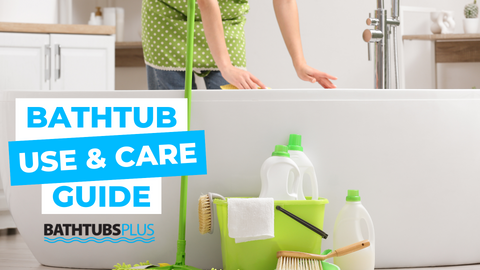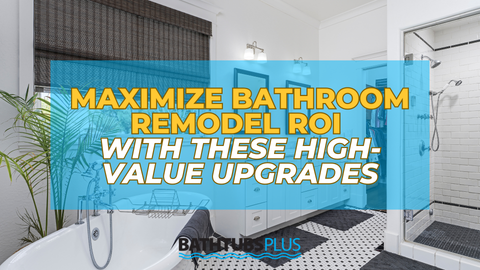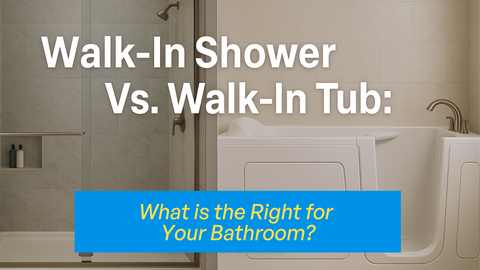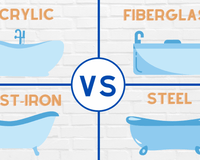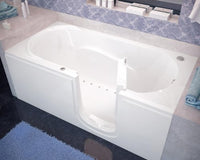People choose walk-in tubs for two main reasons: safety and accessibility. This tub goes beyond the usual function of a bathtub, with special features that cater to people with special bathing needs. While it’s more costly than traditional tubs, it’s a wise investment if you think long term. Its innovative safety features can save you on emotional and financial costs of an assisted living center–or worse–an ER visit, making it highly recommended by bathroom safety experts.
Whether you’re repurchasing or a first-time buyer, it’s best to do proper research first. The last thing you want is to buy the wrong product and waste your time, effort and money. How can I ensure that Mom doesn’t slip while bathing? What can I do to make it easier for Dad to get into the bathtub? Find answers to these questions with this complete walk-in tub buyer’s guide and discover yourself the wonders of a walk-in tub.
| How to choose a walk-in tub? Things to consider: |
What is a walk-in tub?

The Walk-in tub’s most defining feature is its walk-in design, where users are able to directly walk into the tub. This makes it a safer and more accessible option for those who need a little more assistance. With walk-in tubs, there’s no more stepping over the usual slippery ledges and high walls of a traditional tub–which can be dangerous and inconvenient for people with limited mobility. It stands above the rest simply because of its inclusive craftsmanship, you won’t see in other tubs.
Who are walk-in tubs for?

While anyone can enjoy a walk-in tub, its overall design and engineering are especially built for:
- Senior citizens and elderly who need a secured bathtub to aid them in their bathing
- Older people who want to age in place rather at nursing homes
- People with physical injuries or athletes who are recovering from a sports accident
- Individuals who have problems with coordination, balance and mobility (i.e, disabled, handicapped, wheelchair users, para- or quadriplegics, amputees, people with Alzheimer's)
- People whose health/skin conditions need hydrotherapy
- Overweight or large users who cannot fit comfortably in a regular tub
Why do you need a walk-in tub at home?
While it’s fairly new in the market, walk-in tubs offer solutions to old, persistent problems that put burden and even danger to people’s bathing. Thankfully, a walk-in tub:
- Eliminates hazards to a senior’s bathroom
- Offers a more convenient and ergonomic support for family caregivers who assist the elderly in their everyday bathing
- Gives seniors and people with mobility concerns the independence they need without compromising safety and comfort
- Allows aging adults to clean their hard-to-reach body parts
- Brings peace of mind to children living with a senior parent but aren’t always at home
- Provides life-improving hydrotherapy benefits that have long been used in physical therapy facilities and hospitals
- Adds home value and makes your bathroom age-in-place ready
Given the overwhelming walk-in tub choices in the market, here are some of the important factors you need to consider to find the right walk-in tub for your home:
1) Tub Size and Design
A good starting point when buying walk-in tubs is to decide which design and size is the best fit for the user’s built, ergonomic requirements, and bathroom configuration. Be as particular as possible with you and your loved one’s bathing needs, as these will dictate which walk-in tub will bring the most convenience and comfort to your family’s daily bath.
 |
Compact Soakers: Soaker walk-ins, a.k.a the sitting bath, allow its bathers to enjoy a full submersion while sitting upright. They have vertical high walls, easy-entry swing doors and a chair- height seat (generally 17-inches high) that won’t require you to stoop down just to be settled in the tub. It has a hollow bathing well (with almost 20 inches of water depth), where you can have a deep, relaxing soak while enjoying other bath luxuries like air or whirlpool massage, foot massage and therapy lights. Many people love soaker designs due to their compact size (often 60 inches or less long) that can negotiate through narrow doorways and fit small bathrooms. |
Lay-down: This tub’s layout is pretty similar to a common lay-down bathtub, except it has an opening door for a more convenient entry and exit. Unlike soaking walk-in tubs, a lay-down walk-in tub is designed to fully accommodate the bather’s body and limbs, making more room to recline and stretch out the entire body. It has relatively low walls and interior than the high-walled soaker walk-ins, so it’s not the most practical option to those who are not capable of bending down too low.

 |
Wheelchair-accessible (WCA): WCA walk-in’s design is the most accessible and convenient option for wheelchair users due to its barrier-free seat, extra-wide doors, and smooth acrylic frame that allow users to easily slide in and out from any wheelchair. The tub has easy-to-swing, outward-opening doors that can be opened and closed with minimal strength compared to its inward-swing counterpart. This functional tub also flaunts a leak-proof door seal, innovative handles and smooth gliding locks that can give people with physical limitations the independence and privacy they need. |
|
Bariatric: One drawback of walk-in tubs is that they are relatively narrow, making them unappealing and uncomfortable to larger users. The bariatric walk-in tub serves large bathers by having all the features of the typical walk-in tub but with a wider frame, door entrance, and 30-inch seat. This tub is usually targeted at individuals weighing 300 lbs. or greater. |
 |
 |
Shower-tub combinations: The walk-in bathtub shower combo offers both the convenience of upright bathing and the efficiency of taking quick showers. This design includes an adjustable, multi-functional shower head, built in the high-walled frame of a common soaker walk-in tub. With this style, the bather has the option to enjoy a long, deep bath or a quick, thorough shower with a variety of sprays– all while sitting down! |
2-person walk-in tub: This tub is made for those who want a shared bathing experience with a partner or an extra room for a caregiver. Designed for multiple users, two-person walk-ins have two wide seats that are positioned either facing or next to each other, with its door in the middle. Enjoy all the benefits of a walk-in tub, twice!

2) Safety Features

According to the Centers for Disease Control and Prevention, more than 1/3 of American adults will experience at least one fall accident every year (That’s about 800,000 hospital admissions annually). Thus, it’s important for walk-in tubs to be equipped with these safety features for a more secured and worry-free soak:
- Extra-low threshold entry (No more large steps and tripping over when entering the tub!)
- ADA (Americans with Disabilities Act) Compliant contoured seat for a more secured sitting space while you bathe
- Ergonomic controls for users with arthritic hands
- Textured, non-slip floor to minimize the risk of slip accidents
- Stable, easy-to-reach grip bars and handrails to keep the user’s balance and coordination when navigating the tub
- Leak-proof, sealed doors to prevent water from trickling out once the tub is filled
- Quick, auto-drain system and discrete overflow to avoid drowning accidents
- Featherlike neck and headrest pillow for a more comforting soak without the neck pains of the usual tub (sometimes an add-on, sometimes built-in)
3) Therapeutic Features

Who says functional cannot be indulging? Despite the walk-in tub’s foremost function which is to bring an inclusive, accessible bathing, it’s not devoid of advanced, therapeutic features that can bring spa-like luxury to your bathroom. Before making an impulsive decision, ask yourself this: Do you need a plain, soaker walk-in tub to just wash in safety or a whirlpool walk-in bathtub that can soothe certain medical conditions? See which therapeutic feature meets your relaxation needs:
Water Jets
A walk-in tub may be equipped with powerful water jets for a targeted, deep massage that can relax stiff muscles and joint pains. These are usually seen on Jacuzzi walk-in bathtubs.
Air Jets
Walk-ins with air jets blow soft streams of air for a softer, more soothing massage that’s often paired with a bubble bath.
Aromatherapy
This walk-in tub is infused with relaxing fragrances. Many people love to add essential oils for that spa-like experience that’s good for the skin! (Friendly reminder: Be sure to check if your oils are safe and compatible with the tub’s jets.)
Chromatherapy
This feature includes healing lights that shine in various colors and help set the mood. They’re typically at the bathtub’s sides or bottom.
Whirlpool and Air Combo
This modern luxury walk-in tub is packed with all the relaxing features a walk-in tub can get: air and water jets, therapy lights, aromatherapy, and multi-functional faucets.
4) Tub Door and Drain Options

Next to the tub’s dimensions and size, it’s equally important to determine if your bathroom configuration can accommodate the tub’s door and drain.
Walk-in tubs have left or right drain options; make sure you choose the option compatible with your existing drains. Identify the tub’s drain orientation by looking from its accessible side. Similarly, walk-in tubs have two door options: inward or outward swinging doors. Choose swing-out doors if you want an easier entry, exit and navigation within the tub, and have enough space for the door to swing. Inward doors are sold more because it takes up minimal space but since the door swings into the tub, moving around inside it can be more difficult.
It’s also crucial to pick a tub door according to the bather’s level of strength and mobility. If the bather has mobility issues but not to the point of needing a wheelchair or caregiver, then swing-ins can be considered. Conversely, other people like wheelchair users and seniors who need a bathing companion may find it easy to enter the tub but hard to get out from the inside. In this case, swing-out doors that can be conveniently pushed away as they exit is a better option.
5) Fill and Drain System

Compared to standard tubs where you just dip inside once the tub is filled with water, walk-in tubs require the bather to sit inside the tub while it’s filling. This setup may pose challenges to the users, so it pays to understand the walk-in tub’s fill and drain system, as well as its temperature regulation.
Fill-up Time
One of the main customer concerns about walk-in tubs is the slow fill-up time. Because walk-in tubs are taller than standard tubs, people think that they use more water, thereby a longer filling time. Surprisingly, its water usage is about the same. An average tub uses 42-80 gallons of water while a walk-in tub uses about 50 gallons.
One practical way to resolve this problem is to choose walk-in tubs with fast-fill technology. Rapid fill faucets speed up the fill time process which can take up to 15 minutes for some models. Modern pressurized faucets deliver more water to the tub, ensuring it fills up in a timely manner. You can spend less time waiting and more time enjoying the bath! Another challenge is being exposed to air during the waiting time, which may leave the bather chilling. To keep the user warm and cozy while waiting, it’s best to choose a model with a heated seat.
Drain System
Draining a walk-in tub similarly requires a bit of a waiting time. Good thing, most walk-in models today include dual drains that significantly reduce the draining time to an average of 2 mins. While most bathtub drains rely on simple gravity to empty a tub, many walk-in manufacturers today are increasingly incorporating pumps to speed up the water flow. House drain conditions also affect the draining time, as pipes with greater width help drain the water at faster rates.
Temperature controls
Given that the user must sit in the tub and shut the door first while it fills with water, there is no chance to adjust and get the right water temperature before you soak in. The bather’s body can also easily acclimate to uncomfortable temperatures, as the water slowly climbs. That’s why it’s important to have anti-scald or thermostatic control valves to better regulate the water’s temperature.
Another crucial factor is to check the tank of your home’s water heater. At least a capacity of 50 gallons is the recommended tank size to ensure that there’s enough hot water to fill your tub at a comfortable temperature, and also for your tub to not quickly cool at the end of the bath.
6) Tub Material

When choosing a walk-in tub, don’t forget to factor in the material because it will greatly determine your walk-in tub’s durability, maintenance and aesthetic appeal. Due to the growing selection of walk-in tubs in the market, the materials used is typically a combination of two or more. The manufacturing process is likewise more complex than we think, to make sure the tubs are quality and durable enough for the users. Still, most walk-in tubs are made out of these two common materials:
Acrylic
Acrylic is a popular material even to luxury walk-in tubs. Acrylic tubs are built with a single, continuous piece of heat-molded acrylic that’s flexible and lightweight enough to form the tub’s seats, headrests, jets and other molding details. Its easy-to-maintain property that can last up to 30 years (of course, with proper upkeep) is a great option for long-term, heavy-duty use. It’s a great insulator too so you can keep your bath warmer for longer durations. Price-wise, acrylic is slightly more expensive than fiberglass due to its manufacturing process. It’s also more costly to repair.
Gel-Coated Fiberglass
Most walk-in tubs are made of fiberglass with a gel coating. Fiberglass is a strong material, made from layers of micro-strings of glass heated together, and then shaped and sprayed with a resin gel coat. It’s more budget-friendly than acrylic but is prone to scratching and surface cracks due to its porosity. To resolve this, some fiberglass tubs include an acrylic gel topcoat to help further protect the tub. Overall, this easy-to-install and lightweight material is a good fit for two-story homes because there’s no need for additional floor support. It’s inexpensive, but they’re not as durable as acrylic. You can expect a fiberglass walk-in tub to last 10-15 years.
Installation and Other Costs

Installing a walk-in tub is not a simple DIY home project. While they have compact, box-like built that can tightly fit in three-walled alcoves, they are bulky and heavy so it’s important to carefully examine whether your bathroom layout, foundation and plumbing system can accommodate it.
When filled with water, the tub can weigh nearly 1,000 pounds, so it really needs strong floor and wall support. A walk-in tub requires complex plumbing and electrical work, especially if it has elaborate smart features. It’s best if you have it installed by a professional so that you’re assured that the tub will work correctly and last many years without any problems.
Pro-tip: If you are installing a walk-in tub into an existing space, it’s more economical to choose smaller models that you can fit in the same space without greatly changing the layout and plumbing. This installation is relatively cheaper and easier so you can save dollars.
Factor in as well other possible costs like flooring and tiling, pipes and heater system, and any additional wirings. With proper planning and budgeting, you can get the most suitable walk-in tub for your home that’s within your reasonable price.
7) Price and Brands
Walk-in tub’s pricing differs depending on the brand, size, color and feature. But the general trend is: the more features, the higher the price. Soakers range from $2,000 to $4,000 while jetted walk-ins can go as high as $10,000.
While the upfront cost can be off-putting, you’ll find the expense worth it given the years you’ll be able to enjoy it. Walk-in tubs can last for decades and grow with you as you age. Even if you don’t have mobility issues now, you can use it today and still reap its benefits later on. You can confidently age in place in your current home, and not have to worry about making changes to your bathroom when you’re already in your senior years.
For buyers who are tight on funds and space, choosing a design that doesn’t force you to reconfigure the room could save you a lot of money. If you want to get your money’s worth, think long-term and prepare beforehand. Consider all the user’s needs and your bathroom requirements, plan for all possible costs and choose top-rated yet cost-efficient brands like Ella’s Bubbles, Venzi Tubs and American Acrylic that deliver on their commitment to provide quality bathing with their quality bathtubs.
What’s the next step?
Now that you have an idea about the ins and outs of a walk-in tub, it’s time to take action:
- Get a product catalog or check tubs online
- Know the features of your chosen tub, its warranty, shipping time and alternatives
- Speak to the store’s customer service representative and ask your specific questions
- Request a quote for the product you’re interested in
We’re happy to help
Everyday, we receive various, unique situations of people wanting to purchase a bathtub. We understand your concerns and we’re happy to talk through your specific questions, to help you find the right tub for your needs and condition.
Here at BathtubsPlus, we believe everyone deserves a safe and easy access to bath. For more queries, concerns or feedback, email us at: sales@bathtubsplus.com or reach us here.


